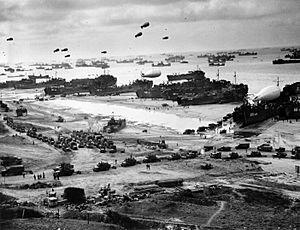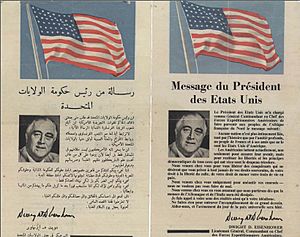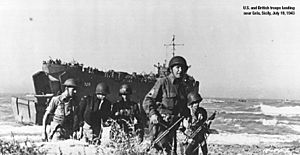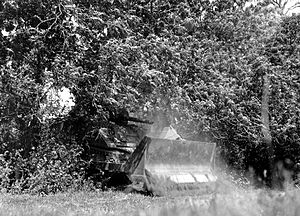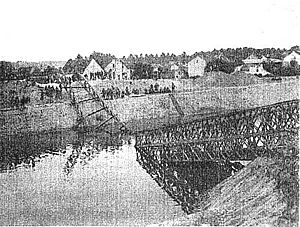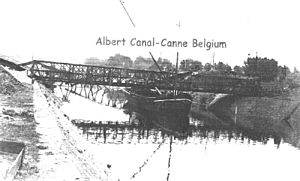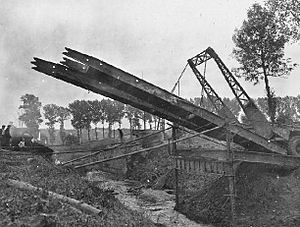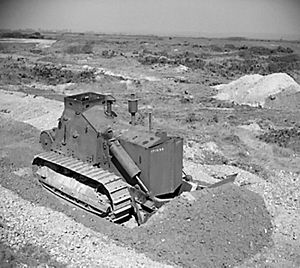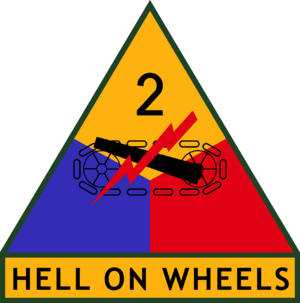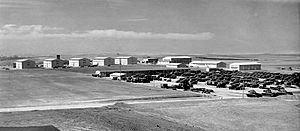17th Armored Engineer Battalion facts for kids
Quick facts for kids 17th Engineer Battalion |
|
|---|---|
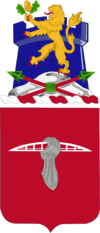
Coat of Arms
|
|
| Active | 1917 – 1995 |
| Country | |
| Allegiance | Regular Army |
| Branch | US Army Corps of Engineers |
| Motto(s) | "WE PAVE THE WAY" |
| Colors | Red and Grey |
| Engagements | World War II Algeria-French Morocco Italy Normandy Alsace Battle of the Bulge Defense of Saudi Arabia Liberation and Defense of Kuwait |
| Insignia | |
| Distinctive Unit Insignia | 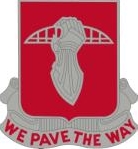 |
The 17th Armored Engineer Battalion was a special unit of the US Army Corps of Engineers. They were part of the famous 2nd Armored Division, also known as "Hell on Wheels." Engineers are like builders and problem-solvers for the army. Their job is to help friendly forces move forward and slow down the enemy. They do this by building and destroying things on the battlefield.
The 17th Armored Engineer Battalion was started on October 1, 1933. It was first called the 17th Engineer Battalion (Heavy Ponton), Motorized. Later, it was renamed the 17th Engineer Battalion (Armored) in 1940. It joined the 2nd Armored Division. The unit began training on July 15, 1940, in Fort Benning, Georgia. Its name changed again in 1942 to the 17th Armored Engineer Battalion.
Their motto was "We pave the way." This meant they cleared paths and built things so other soldiers could advance. Their tasks included building and destroying structures during battles. They also built and broke down trenches and tank traps. They built bunkers, roads, and bridges. They also laid and cleared land mines. They did any physical work needed on the battlefield.
Contents
World War II Training
Training for the 17th Armored Engineer Battalion began at Fort Benning, in Columbus, Georgia. The soldiers were about 22 years old on average. They had already completed two and a half months of basic training.
Their special training included many important skills. They learned how to shoot the M1 carbine rifle. They also learned about minefields and how to remove mines. They practiced building bridges over dry ditches and floating Pontoon bridges. Road repair and using special army vehicles like DUKWs were also part of their training. They even did Live fire exercises and practiced with real mines to get ready for battle. Colonel George S. Patton was in charge of training the entire 2nd Armored Division.
World War II
During World War II, the 17th Armored Engineer Battalion traveled with the 2nd Armored Division. They went to North Africa, Sicily, England, France, Belgium, and Germany. They were under the command of the First Army.
North Africa
The 17th Battalion took part in the North African Campaign. This included Operation Torch, where they landed in Algeria and Morocco. Their main job in North Africa was to clear landing areas and remove mines. The 17th landed early on November 8, 1942. In Morocco, they landed in Safi as part of Operation Blackstone.
Sicily
As part of Operation Husky order of battle in the Sicily Campaign, the 17th Armored Engineer Battalion landed in Gela, Sicily. This was in south-central Sicily, on July 11, 1943. Before landing, the 17th used M4 Sherman tanks with special Scorpion Mine flails. These flails helped clear the way by exploding mines. The operation helped capture Butera and they fought in the Battle of Mazzarino. Then, they moved on to Palermo. After fighting in Sicily, the 17th moved to England. There, they trained and got ready for D-Day.
Normandy
On June 9, 1944, just three days after D-Day, the 17th battalion landed on Utah Beach in Normandy. This was part of the Normandy landings and Operation Overlord. Their job was to clear paths for landing boats. They destroyed steel structures with mines that the Germans had placed in the water. They also used bulldozers to make roads up the narrow paths through the cliffs.
For D-Day, the 17th Armored Engineer Battalion received new camouflage uniforms. These were the same uniforms used by the US Marine Corps in the Pacific. To clear roadblocks, minefields, and break through thick hedgerows, the 17th used M4 Sherman Tanks. These tanks had M1 bulldozer blades attached. They also used Caterpillar D7 bulldozers with extra armor plates. These tank bulldozers helped them break through the hedgerows in France.
The Germans learned to wait until tanks crossed and then fire on the soldiers following on foot. To fight back, the American forces started firing their main guns with special ammunition as they crossed. This helped clear the enemy hiding in the hedges. This tactic became known as "Roosevelt's Butchers." From Omaha Beach, the battalion pushed through the Cherbourg peninsula. They also built a bridge across the Seine river in France.
Albert Canal Bridge
After the Battle of Fort Eben-Emael, the 17th and 82nd Armored Engineer Battalion worked together. They built a Bailey bridge across the Albert Canal in the village of Kanne. Their first attempt failed, and the bridge fell into the canal. But on September 15, 1944, with the help of a boat for support, they successfully completed the bridge. The Albert Canal was an important defense line for the retreating enemy.
Geleenbeek Stream
On September 18, 1944, the 17th built a bridge across the Geleenbeek stream. This was near Kathagermolen. All the other bridges across the stream around Schinnen had been destroyed by the retreating German army. While building, enemy machine guns fired at the engineers from the trees. The gunfire missed the engineers. A US tank fired back, silencing the enemy guns. Two 60-foot beam bridges were finished: one at Kathagermolen and one at Schinnen.
The 17th often fought in Alsace. On November 26, 1944, in Ciney, Belgium, they were part of the Ardennes Offensive. A platoon from the 17th Engineers helped hold Ciney against the enemy. The 17th Armored Engineers were also ordered to secure Merzenhausen and Barmen. This was to cut off enemy communication lines to the Roer river as part of Operation Queen. In Lonlay-l'Abbaye, the 17th blew up a bridge in the town center. Then they moved on to destroy an enemy ammunition dump.
Battle of the Bulge
During the Battle of the Bulge, the engineers acted quickly. They destroyed important bridges in the path of the German forces. This slowed down and redirected the enemy. It gave the Allied forces time to regroup. The Battle of the Bulge was fought in very cold weather from December 16, 1944, to January 25, 1945.
Seine River
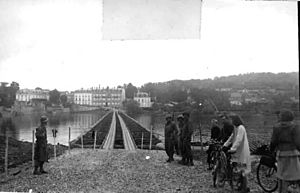
The 17th Armored Engineers and the 82nd Engineer Combat Regiment built a floating bridge over the Seine River. This was in Meulan, France, on August 30, 1944. They started at 8 AM and opened the bridge at 6 PM. It was 720 feet long. The 17th bridge company did not have enough parts for the floating sections. So, they built a short wooden bridge near the far end. The paths leading to the bridge were made of special mats and gravel.
Rhine Crossing
On the night of March 23, 1945, as part of the Western Allied invasion of Germany and Operation Plunder, the 17th Armored Engineer Battalion helped cross the Rhine River. Companies E and C built two special rafts. These were for crossing the Rhine River about five kilometers south of Wesel. Bridge construction started at 9:45 AM. By 4:00 PM, the first truck crossed the floating bridge. They used over 1152 feet of M2 treadway and 93 inflatable floats. They built this large bridge in just six hours and fifteen minutes, setting a record. Twenty-five 2½-ton GMC CCKW trucks transported the bridge parts. This was part of the Red Ball Express supply route.
A steel treadway bridge needs floating pontoons. A saddle on top of the pontoon holds the bridge's weight. Twelve-foot sections of treadway track are bolted to these saddles. The treadway sections were put together on the spot. They were unloaded from many trucks. The sections were then taken to the end of the bridge being built. They were connected with large steel pins. The 17th was good at building treadway bridges, but this was their biggest one. To cross the Rhine, they needed 80 or 90 sections. Moving the sections and pounding in the large pins was hard work. These bridges could carry heavy loads, including 66,800-pound M4 tanks. The floating pontoon was an 18-ton inflatable rubber bag. The saddle was a metal and plywood frame placed on the float. It supported the treadway tracks. To get the bridge ready, the pontoons had to be inflated. The saddles had to be put together and tied to the top of the pontoons.
On March 30, 1945, Company "C" built a treadway bridge across the canal near Alvert. On April 5, 1945, the 17th Engr. Bn. built a 384-foot treadway bridge across the Weser at Ohr, Germany. On April 8, 1945, division engineers built a pontoon bridge across the Weser Elbe Canal, west of Harsum. This allowed Company "A" to continue its drive northeast to Braunschweig.
Elbe River
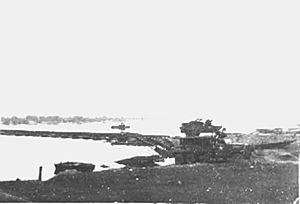
The engineers helped ferry two battalions across the Elbe river. Then they started building a floating bridge at Westerhusen. On the night of April 12 to 13, 1945, they worked on a bridge across the river. Companies D and E of the 17th Armored Engineer Battalion started building at 11 PM. It was a very dark night, even with two search lights. In the dark, the bridge came together quickly.
As daylight came, engineers used smoke pots to create a smoke screen. This hid the bridge construction from the enemy. But at 6 AM, enemy shells destroyed five bridge floats. Work stopped. By 7 AM, work started again to finish and repair the bridge. By 2 PM, the bridge was almost done, with only 25 feet left. But so much enemy artillery fire was falling that the engineers were told to leave the bridge. They loaded their trucks and pulled out to prevent more damage. PFC William Horne, who was helping with the bridge, was killed during construction. The unit moved to Grunewalde, where a ferry would take them across. The 17th engineers helped with the ferry operations using their DUKWs.
On April 17, the 17th Armored Engineer Battalion finished building a bridge across the Elbe River at Magdeburg. The construction team faced enemy fire and even an attack from the Luftwaffe (German air force). April 25, 1945, is known as Elbe Day. This is when the Western and Eastern armies met near the bridge here.
Back to the US
On January 21, 1946, the battalion was shipped from Calais, France. They arrived at Ft. Hood, Texas, on February 12, 1946.
Cold War
After World War II, the 17th Armored Engineer Battalion was based in Dexheim, Germany. From 1953 to 1954, Anderson Barracks was their home. The engineers' job was to help the armored units of the Second Armored Division move easily. Their mission was to help stop any Soviet invasions through the Fulda Gap. This was a key area in Germany. An annual training event was installing a floating bridge across the Rhine River, just like they did in World War II.
In 1967, some parts of the 17th were assigned to the 198th Light Infantry Brigade. In 1978, Delta Company of the 17th Engineers was stationed in Garlstedt, Germany. They were part of the 2nd Armored Division (Forward). During the Cold War, D Company's role was to get ready for heavy armored combat. This was to defend NATO against the Warsaw Pact (Soviet Union and its allies). They needed to be ready to move if the Soviets threatened NATO. The 17th and its division practiced during exercises like REFORGER. These exercises happened from 1967 to 1988. Some training also took place at the National Training Center at Fort Irwin, California.
Panama
The 17th took part in Operation Just Cause. This was the United States invasion of Panama on December 20, 1989. They helped with landing and dock operations during this short but complex mission.
Gulf War
The 17th served in Saudi Arabia and Kuwait. In the fall of 1990, the 17th went to Saudi Arabia. This was part of Operation Desert Storm. They supported heavy armor divisions in the Defense of Saudi Arabia. Later, they helped in the liberation of Kuwait. The 17th took part in the Battle of Norfolk. This battle involved tank fights and ground infantry. The 17th's role was similar to World War II, with mine removal and other support tasks.
The battalion was officially stopped in 1995.
Insignia
- The battalion's insignia shows a shield and its motto.
- Motto: "We pave the way."
- The shield is red, which is the color for Engineers.
- It shows a mailed fist holding a portable ramp. This means the unit is strong and ready to build paths.
- The blue tower on the crest stands for their actions in World War II. They received a special award for fighting in fortified towns.
- The white snow mound reminds us of the cold and icy conditions during the Ardennes-Alsace campaign.
- The gold lion is from Belgium's coat of arms. The acorn and leaves represent the forests of the Ardennes and courage.
- The colors green and red honor a Belgian award the unit received.
- The two spears show their service with the 2nd Armored Division. This division led the way into Belgium and broke through enemy defenses. The spearheads also represent their landing attacks in North Africa and Sicily during World War II.
Decorations and Honors
- Presidential Unit Citation (Army), for fighting in the "Ardennes" (December 22, 1944 – January 17, 1945).
- Presidential Unit Citation (Army), for fighting from the "Rhine to Elbe River" (Company E, March 11 – April 13, 1945).
- Belgian Fourragere 1940 (a special award from Belgium).
- Cited by the Belgian Army for actions in BELGIUM (September 2, 1944).
- Cited by the Belgian Army for actions in the ARDENNES (December 21–28, 1944).
- Navy Unit Commendation, for service in SAUDI ARABIA-KUWAIT (Company A, August 14, 1990 – April 16, 1991).
- Distinguished Unit Citation: Company E, 17th Armd. Engr. Bn.: March 11, 1945, to April 13, 1945, during the advance from the Rhine to the Elbe River.
- Distinguished Unit Citation: 17th Armd. Engr. Bn.: December 22, 1944, to January 17, 1945, for operations during the German Ardennes breakthrough.
- President Truman reviewed the Second Armored Division in Berlin on July 16, 1945. He tied a citation award to the guidon flag of Company E, 17th Armored Engineer Battalion.
See also
- 82nd armored reconnaissance battalion
- Mine plow
- Mine roller
- Hobart's Funnies
- Allied technological cooperation during World War II
- History of the tank
- Tanks in World War I
- Tanks in World War II
- Comparison of early World War II tanks


